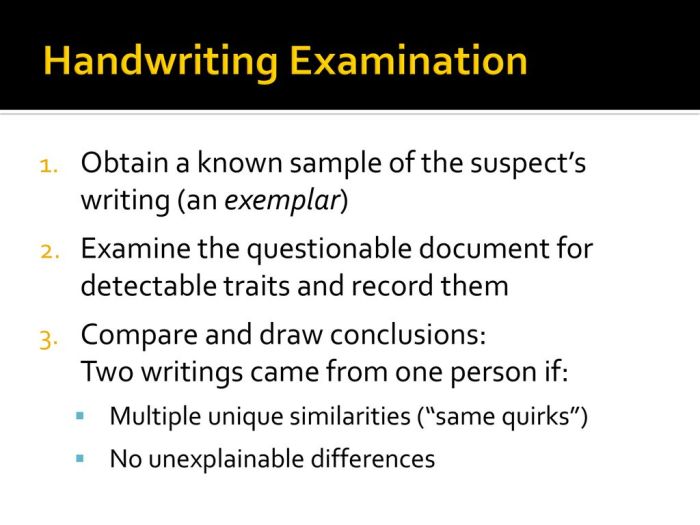What is an exemplar in forensics? In the realm of forensic science, exemplars play a pivotal role in establishing a foundation for comparison and identification. This comprehensive guide delves into the intricacies of exemplars, exploring their purpose, significance, collection, analysis, and ethical considerations.
Exemplars, also known as known samples, are physical or digital specimens obtained from an identified source. They serve as reference points against which questioned samples are compared to determine their origin or identity.
Definition of Exemplar in Forensics
In forensic science, an exemplar refers to a known sample or reference material that is used for comparison and identification purposes. Exemplars are collected from individuals or objects to establish a baseline or standard against which questioned samples or evidence can be evaluated.
Common examples of exemplars in forensic investigations include:
- Blood or saliva samples for DNA analysis
- Handwriting samples for document examination
- Fingerprint impressions for fingerprint identification
- Known firearms or ammunition for ballistics testing
- Shoe impressions or tire tracks for crime scene reconstruction
Purpose and Significance of Exemplars
The primary purpose of using exemplars in forensic analysis is to provide a basis for comparison and identification. By comparing questioned samples to known exemplars, forensic examiners can establish similarities or differences, which can assist in determining the source or origin of the evidence.
Exemplars help establish a foundation for identification by providing a known reference point against which questioned samples can be evaluated. This comparison process allows forensic examiners to draw conclusions about the identity or characteristics of unknown substances or individuals.
Collection and Preservation of Exemplars
The proper collection and preservation of exemplars are crucial to ensure their integrity and admissibility in forensic investigations. Exemplars should be collected in a manner that minimizes contamination or alteration and preserves their original condition.
Methods for collecting exemplars vary depending on the type of evidence. For example, blood samples are typically collected using sterile needles and syringes, while fingerprint impressions are taken using ink or powder.
Preservation techniques also vary, but generally involve storing exemplars in a secure and controlled environment to prevent degradation or contamination. Maintaining the chain of custody is essential to ensure the integrity of exemplars throughout the collection, analysis, and reporting process.
Comparison and Analysis of Exemplars

The process of comparing exemplars to questioned samples involves a variety of techniques, depending on the nature of the evidence. Microscopy is commonly used to examine physical characteristics, while spectroscopy and DNA analysis are employed to identify chemical or genetic similarities or differences.
Forensic examiners use their expertise and knowledge of specific techniques to compare exemplars to questioned samples. They evaluate similarities and differences in appearance, composition, or other relevant characteristics to determine whether they match or are related.
Role of Exemplars in Forensic Reporting: What Is An Exemplar In Forensics
Exemplars play a significant role in forensic reporting by providing support for findings and conclusions. Forensic examiners use exemplars to demonstrate the basis for their identifications or conclusions in a clear and concise manner.
In forensic reports, exemplars are often presented as tables or figures that compare the characteristics of the questioned sample to the known exemplar. This allows readers to visualize the similarities or differences and understand the rationale behind the examiner’s conclusions.
Ethical Considerations in Exemplar Use

The use of exemplars in forensic investigations raises ethical implications that must be carefully considered. It is important to respect the privacy and rights of individuals whose exemplars are collected.
Forensic examiners must ensure that exemplars are collected with informed consent and that they are used only for legitimate forensic purposes. Additionally, the privacy of individuals must be protected by ensuring that exemplars are stored securely and only accessed by authorized personnel.
Case Studies and Examples
Exemplars have been used in numerous forensic investigations to solve crimes and exonerate individuals. One notable case involved the identification of a suspect in a murder investigation using DNA analysis. By comparing DNA from the crime scene to exemplars collected from potential suspects, forensic examiners were able to identify the perpetrator.
In another case, exemplars were used to exonerate an individual who had been wrongly convicted of a crime. By comparing fingerprint exemplars to those found at the crime scene, forensic examiners were able to prove that the individual was not present at the time of the crime.
FAQ Overview
What is the purpose of an exemplar in forensics?
Exemplars provide a known reference point against which questioned samples can be compared to determine their origin or identity.
How are exemplars collected and preserved?
Exemplars should be collected using proper methods to ensure their integrity and admissibility. The chain of custody must be maintained to document the handling and transfer of exemplars.
What techniques are used to compare exemplars to questioned samples?
Various techniques are used, including microscopy, spectroscopy, and DNA analysis, depending on the nature of the exemplars and questioned samples.
